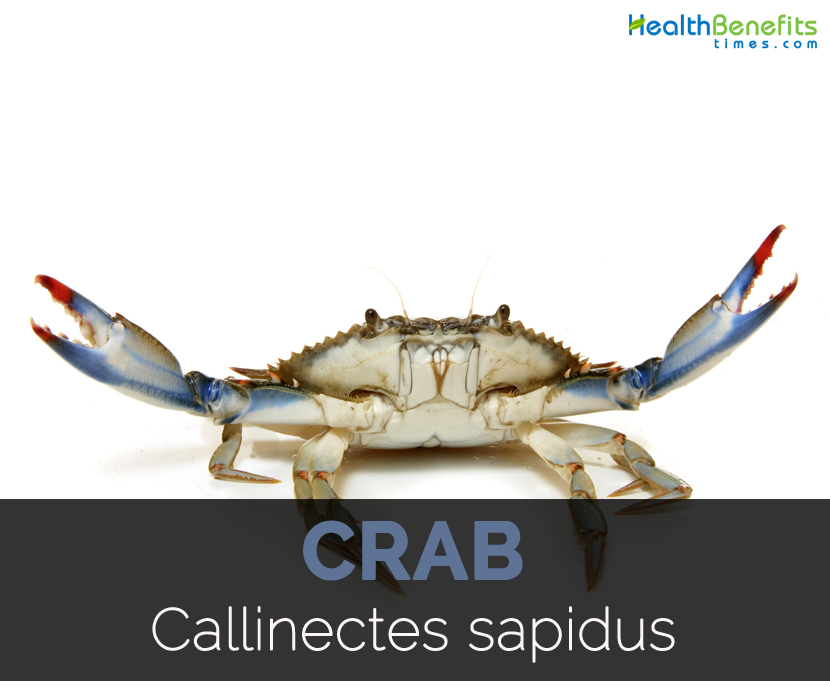| Crab facts and health benefits Quick Facts |
| Name: |
Crab facts and health benefits |
| Scientific Name: |
Callinectes sapidus |
| Origin |
Native to Western Atlantic Ocean and Gulf of Mexico |
| Colors |
Blue to olive green |
| Shapes |
Width: 23 cm (9.1 inches); Carapace length: 25 cm |
| Taste |
Soft, delicate and sweet |
| Calories |
82 Kcal./cup |
| Major nutrients |
Vitamin B-12 (407.50%)
Copper (111.67%)
Selenium (61.82%)
Sodium (60.73%)
Zinc (58.91%)
Tryptophan (52.05%)
|
| Health benefits |
Healthy bones, Mental health, Heart health, Lowers inflammation, Enhance immunity |
| More facts about Crab facts and health benefits |
Callinectes sapidus also called Atlantic blue crab, The Blue crab and Chesapeake blue crab. It is native to Western Atlantic Ocean and Gulf of Mexico. It is a decapod crab that belongs to the family Portunidae. It is quite similar to shrimp, prawns and lobster. There are about 6700 crab species and 93 crab groups. It is omnivores that live on an oceans, fresh water and land. It has the lifespan from three to four years. It measures upto 23 cm (9.1 inches) wide and 25 cm carapace long. The leg spans measures about 4 meters (13 ft) long. It has thick and armoured shell which is 9 inches across. It is blue to olive green in color with bright blue claws. The taste is soft, delicate and sweet.
Nutritional value
In 85 grams of cooked crab, it covers 65.92 grams of moisture, 82 calories, 16.45 grams of protein, 1.31 grams of total lipid fat and 1.57 grams of ash. It grants 407.50% of Vitamin B12, 111.67% of copper, 61.82% of selenium, 60.73% of sodium, 58.91% of zinc, 52.05% of tryptophan, 47.67% of isoleucine, 42.79% of lysine, 37.84% of threonine, 36.65% of valine, 35.34% of leucine, 34% of phosphorus, 32.90% of protein, 27.11% of histidine, 12.86% of magnesium, 11.77% of Vitamin B6 and 10.75% of Vitamin B9.
Health Benefits of Crab
As it is quite popular in the seafood, it is loaded with various amounts of health benefits. It promotes the heart health, lowers inflammation, enhance immunity, detoxification and enhance circulation. It is loaded with various amounts of minerals, nutrients, fats which is essential for the functioning of the body. In addition to that, it also contains omega-3 fatty acids and selenium.
- Healthy bones
Phosphorus is essential for the maintenance of bones and teeth. It has high content of phosphorus which is vital food. The foods rich in phosphorus such as crabs help to prevent the chances of suffering osteoporosis. (1)
- Mental health
Crab is loaded with various nutrients such as Vitamin B2, copper, omega 3 fatty acids and selenium. It is vital for the cognition and nervous activities. It strengthens myelin and prevent nervous system. It also lowers inflammation and plaque. (2)
- Heart health
The crab’s meat is rich in omega-3 fatty acids. It helps to balance the level of cholesterol and enhance anti-inflammatory properties. It lowers the blood pressure, reduce strain on heart and prevent the chances of atherosclerosis. It lowers the chances of stroke and heart attack. (3)
- Lowers inflammation
The nutrients and minerals found in crabs help to lower inflammation. It also contains selenium, copper, omega-3 fatty acids. It should not be consumed by the patients of gout, arthritis, gastrointestinal problems. (4)
- Enhance immunity
Selenium is associated with enhancing immunity and acts as antioxidant activity to prevent the chronic ailments in the body. It helps to eliminate the free radicals that could mutate the cells. Crab meat has adequate amounts of selenium and riboflavin that raise the antioxidants. (5)
- Detoxification
The immunity system of the body assists in blood, liver and kidney detoxification. Crab has phosphorus that enhances the function of kidneys and eliminates toxins and also enhances the metabolic efficiency. (6)
- Assist circulation
Copper is essential for the functions of organs. It is vital for the iron absorption of gut. Iron is essential for the red blood cells production. It enhances the circulation and promotes the oxygenated blood to the body parts. It speeds up the healing process and cell regrowth during illness and injury. (7)
https://www.youtube.com/watch?v=t5Dwl47gYxc
How to Eat
- It is consumed whole along with shell.
- Crab cake could be prepared by mixing the flour to the crab meat.
- It could be used fresh or canned.
Precautions
- People who are allergic to sea food should not consume it.
- It should be consumed in adequate amounts.
- The meat of crab has high content of cholesterol and sodium.
- The people with cardiovascular problems or high cholesterol problems should not consume it regularly.
https://www.organicfacts.net/health-benefits/animal-product/health-benefits-crab.html
Other Facts
- Males are called jimmies and mature females are known as sooks.
- It has five pair of legs.
- They are omnivores which eat both plants and animals.
- Japanese Spider Crab has a leg span that measures 12 feet.
- Crab could swim and walk.
- The crab’s pregnancy last from one to two weeks and deposits from 1000 to 2000 eggs.
- The mating occurs only once in female blue crabs.
References:
https://en.wikipedia.org/wiki/Crab
https://www.msc.org/cook-eat-enjoy/fish-to-eat/crab
http://www.softschools.com/facts/animals/crab_facts/127/
http://www.chesapeakebay.net/fieldguide/critter/blue_crab
https://kidskonnect.com/animals/crab/
Comments
comments


